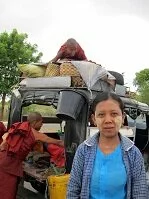Also, be aware that the Muslim minority (found especially in the west) refrains from drinking alcohol and from eating pork products so it is best to avoid these foods when in their presence. The Hindus (also found primarily in the west and the north) believe cattle are sacred so when in their presence avoid eating beef. However, the majority of the population is Buddhist and they have no eating and few other behavioral restrictions outside what is mentioned above.
Dress

Local in Bagan
The people of Myanmar wear traditional clothing more than other people in the region and this becomes obvious as soon as you enter the country. Although most people wear western shirts, they wear longyi (or sarongs) instead of pants and everyone wears these long cloths wrapped around their waists. The longyi are generally dark in color and they complement the thanakha, which is similar to make-up wore by both men and women. This yellow substance offers protection from the sun, moisture to the face, and beautification for the wearer. Men generally only put this yellow substance on the tip of their noses and a dot on each check, but women wear large amounts of it on each check and on their foreheads. There are also a large number of monks in the country, who wear red robes and shave their heads; women engaged in the monastic life also shave their heads, but wear pink robes.
Despite the local dress, there are few dress restrictions in Myanmar and the visitor is under no obligation or expectation to dress as the locals do. Although few locals wear shorts, there is no discourtesy involved in wearing them as this is a cultural phenomenon, not a religious rule. Of course if you are visiting temples or other sights of particular religious or political importance you may be expected to cover up with long pants and shoulders should be covered at a minimum. Sunbathing naked or women sunbathing topless is never permitted, even on beaches.